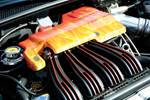Exceeding the Limits
Three novel fiber-reinforced, high-temperature thermoplastics promise part designers a broader means to push past performance barriers.
Fiber-reinforced, high-temperature thermoplastics are comparatively new in the expanding universe of commercialized thermoplastics. On the outer edges of that expansion are three novel products that promise part designers broader means to push past performance barriers.
The topic of high-temperature thermoplastics does not usually bring to mind polypropylene (PP). Yet if testing and validation work currently underway at Asahi Kasei Plastics North America Inc. (Fowlerville, Mich.) pans out, this ubiquitous polymer could someday be a player in the market for elevated-temperature, automotive underhood applications.
Using a proprietary technology that couples glass fibers to the polymer chain, Asahi Kasei has produced a PP grade with a heat deflection temperature (HDT) of 151°C/304°F. At that temperature, Thermylene P9 chemically coupled PP, as the product is called, could be suitable for air intake manifold applications on smaller engines (e.g., four-cylinder engines with displacements of 2 liters or less). A 30 percent glass-filled grade of Thermylene P9 is about 16 percent lighter than an identically filled polyamide. Also, unlike nylon, polypropylene is nonhygroscopic. Ramesh Iyer, Ashai Kasei’s VP of commercial operations, says the product is currently available in several nonautomotive products. He also reports that ongoing oven-aging studies of Thermylene P9 show no loss of mechanical or thermal properties after 2,500 hours of exposure. The product, is currently under evaluation for several automotive projects.
Always high-temperature capable, polyphenylene sulfide (PPS) has found a place in aircraft manufacture. In fact, the carbon fiber-reinforced version of Ticona Engineering Polymers’ (Florence, Ky.) Celstran CFR-TP-PPS unidirectional continuous-fiber PPS tape is used on the leading edges of the Airbus (Toulouse, France) A380 jetliner’s wings. The company is now looking for opportunities to use the tape, reinforced with glass, carbon or aramid fiber, to make components in high-volume automotive platforms. Bob Newill, Ticona’s market development engineer, says the tape would be a good fit for all-electric and hybrid-electric vehicles, where lightweighting is a top priority. The material’s inherent flame- and chemical-resistance also would help manufacturers meet ever more strict safety standards.
Although polyamides today are no strangers to underhood temperatures, polymers at the high-temperature end of the nylon spectrum are typically formulated from petroleum-based monomers. DSM Engineering Plastics’ (Evansville, Ind.) Eco-PaXX, however, is a 70 percent bio-based nylon 4/10 with a continuous operating temperature range of 150°C to 180°C (302°F to 356°F). DSM introduced this castor bean oil-based polymer to the market about two years ago and has since received several commercial orders. EcoPaXX Q-HGM 24, a 10 percent glass fiber- and 20 percent mineral-filled grade, is used to manufacture the engine cover for a twin-turbo V-8 engine in a BMW vehicle. The cover reportedly can withstand a peak temperature of 230°C/446°F. Jim Conkey, product manager for DSM’s Stanyl brand polymers, adds, “The material has much lower moisture absorption than [petrol-based] nylon, but it molds like nylon 6 and provides good surface aesthetics.”
Related Content
-
BMW Group to bring iX5 Hydrogen pilot fleet into service in 2023
A fleet of under 100 vehicles, featuring BMW fuel cell technology and 700-bar CFRP storage tanks, will be deployed for international demonstration and trial purposes.
-
Composites end markets: Batteries and fuel cells (2024)
As the number of battery and fuel cell electric vehicles (EVs) grows, so do the opportunities for composites in battery enclosures and components for fuel cells.
-
SMC composites progress BinC solar electric vehicles
In an interview with one of Aptera’s co-founders, CW sheds light on the inspiration behind the crowd-funded solar electric vehicle, its body in carbon (BinC) and how composite materials are playing a role in its design.















